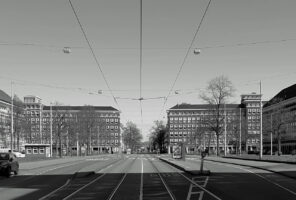Doom
Published as Carpenters Eye column on: website Architectenweb, May 2020
 In contrast to architecture and secular ideologies such as liberalism, socialism and Marxism, religions have devised ways to cope with death. The architectural profession is opportunistic. It is both a strength and a weakness. In times of Covid-19, fellow professionals have plunged into socially-distanced society. I note the support of some random architecture critics: ‘I find the (improvised) design for a local micro-market in Rotterdam extremely inspiring’ and ‘The drive-in industry is rapidly being enriched with new concepts, of which drive-through condolence is the innovative highlight’. But Ole Bouwman tops the list: ‘Distance as a creative challenge. Urban ballet. Design of the diversions. Social dis-dancing’.
In contrast to architecture and secular ideologies such as liberalism, socialism and Marxism, religions have devised ways to cope with death. The architectural profession is opportunistic. It is both a strength and a weakness. In times of Covid-19, fellow professionals have plunged into socially-distanced society. I note the support of some random architecture critics: ‘I find the (improvised) design for a local micro-market in Rotterdam extremely inspiring’ and ‘The drive-in industry is rapidly being enriched with new concepts, of which drive-through condolence is the innovative highlight’. But Ole Bouwman tops the list: ‘Distance as a creative challenge. Urban ballet. Design of the diversions. Social dis-dancing’.
The one-and-a-half-metre (or whatever) society has overcome the world. Only, the word ‘society’ is far too big. Forced distancing is crisis-intervention. It is a public order measure devised by virologists. Our critics forget that in the remaining decimated markets in Europe one and a half metres measures have long been compulsory. They are makeshift. Nobody likes them.
The funeral experience which you now often experience entirely in your own car (perhaps with plastic-wrapped cups of instant coffee and snacks on the dashboard) is perhaps a promising idea. After all, the car is the hygienic means of transport par excellence. This new car-mobility will cause us spatial problems, but that is another story. For the moment the procedure is as desirable as a shabby drive-in cinema.
That new public order is defined by restrictions. Keeping a fearful distance should not be confused with challenging dignified and culturally-rooted living together. So the design of that new defensive public order is best left provisional. Embellishment merely creates another design gap between a troubled humanity and well-meaning designers.

Ole Bouwman may repackage such pettiness as urban dances, but it has little to do with architecture. There is no poison in it – by which I refer to musician-artist Brian Eno, who once tweeted an ominous statement which I took metaphorically: ‘The trouble with New Age music is that there’s no evil in it’. Read again what the architect Adolf Loos wrote: ‘If we find a mound six feet long and three feet wide in the forests, formed into a pyramid, shaped by a shovel, we become serious and something says, “someone lies buried here” … Now that is architecture’.
In the world of yore, the cemetery was next to the church in the village. The churchyard made doom visible in everyday life. It is no coincidence that Adolf Loos found his burial mound in a place outside the city, in a forest. In the metropolis that was Vienna a century ago, there were only cemeteries, there were no longer any churchyards. Death was far away. Loos questioned how the detached city-dweller related to doom. The final manifestation of this was the burial mound isolated in a forest, a grave reduced to a mound of earth as large as the man who rests beneath it. Simple and anonymous though it may be, the burial mound is far from being temporary.
Loos worked with known rituals and cultural desires. Architects are condemned to opportunism, optimism and can-do, sure. That does not exclude the possibility that they design houses for weddings and birth-parties with Loosian obstinacy in an architecture that also endures the doom of illness, death and mourning. That is dignity. Or style. Durability for my part. Architecture serves life in all its facets. And remains silent.

Ten years ago, a group of students designed a grave monument for Adolf Loos. In a brick factory, they laid out their design with the bricks they found there. They chose double-fired, deeply black, bricks and stacked them in an elongated double-symmetrical pyramid. It was obvious. Then a student noted that a ‘head’ to the grave was missing. The students dismantled the tomb. They laid another pyramid, this time asymmetrical. Simple. It became quiet. The students no longer dared to walk on the bricks. They fixed the scene in their minds, made photos and after a while they put the blackened bricks back in the factory and went home.
Text editing English translation: Charles Rattray
